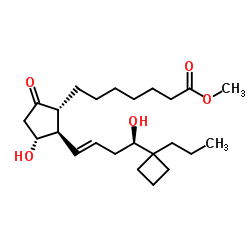Stimulation of prostaglandin EP2 receptors on RGC-5 cells in culture blunts the negative effect of serum withdrawal.
Kui Dong Kang, B L S Andrade da Costa, N N Osborne
Index: Neurochem. Res. 35(5) , 820-9, (2010)
Full Text: HTML
Abstract
Reduced neurotrophic support is one possible cause for retinal ganglion cells dying in glaucoma. Experiments were designed to investigate the effect of EP2 receptor agonist butaprost on transformed retinal ganglion (RGC-5) cells where reduced neurotrophic support was simulated by serum withdrawal. Cultures were analysed for cell viability, flow cytometry, reactive oxygen species and apoptosis. Western blot and immunohistochemistry were used to provide information for the occurrence of PGE(2) receptor-types. We demonstrated the existence of all four types of PGE(2) receptors in RGC-5 cells and exposure of cultures to butaprost resulted in an elevation of cAMP. Serum deprivation induced RGC-5 cell death was significantly attenuated by butaprost as well as by rolipram and forskolin where intracellular cAMP levels were increased. These data are of value in relation to the possible use of EP2 receptor agonists to reduce both elevated intraocular pressure and retinal ganglion cell death as occurs in glaucoma.
Related Compounds
| Structure | Name/CAS No. | Molecular Formula | Articles |
|---|---|---|---|
 |
(R)-Butaprost
CAS:69648-38-0 |
C24H40O5 |
|
Role of hypoxia-inducible factor 1, α subunit and cAMP-respo...
2013-07-01 [Am. J. Respir. Cell. Mol. Biol. 49(1) , 105-13, (2013)] |
|
Resting but not CpG stimulated keratinocytes suppress autolo...
2011-05-01 [Exp. Dermatol. 20(5) , 394-400, (2011)] |
|
Fibroblast-specific expression of AC6 enhances beta-adrenerg...
2010-06-01 [Am. J. Physiol. Lung Cell. Mol. Physiol. 298 , L819-29, (2010)] |
|
Involvement of the prostaglandin E receptor EP2 in paeoniflo...
2013-02-01 [Anticancer Drugs 24(2) , 140-9, (2013)] |
|
Indomethacin antagonizes EP(2) prostanoid receptor activatio...
2012-04-05 [Eur. J. Pharmacol. 680(1-3) , 16-21, (2012)] |